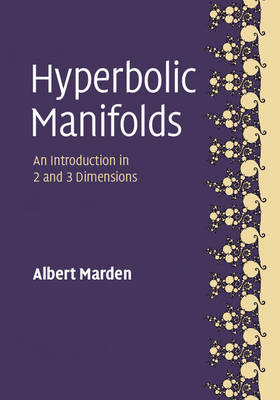
Hyperbolic Manifolds
An Introduction in 2 and 3 Dimensions
Seiten
2016
Cambridge University Press (Verlag)
978-1-107-11674-0 (ISBN)
Cambridge University Press (Verlag)
978-1-107-11674-0 (ISBN)
This richly illustrated study of hyperbolic geometry in low dimensions takes the reader from first principles to the current state of knowledge. Marden begins by explaining basic ideas and techniques before applying them to the description and classification of the interiors of 3-dimensional objects. Each chapter ends with exercises and explorations.
Over the past three decades there has been a total revolution in the classic branch of mathematics called 3-dimensional topology, namely the discovery that most solid 3-dimensional shapes are hyperbolic 3-manifolds. This book introduces and explains hyperbolic geometry and hyperbolic 3- and 2-dimensional manifolds in the first two chapters and then goes on to develop the subject. The author discusses the profound discoveries of the astonishing features of these 3-manifolds, helping the reader to understand them without going into long, detailed formal proofs. The book is heavily illustrated with pictures, mostly in color, that help explain the manifold properties described in the text. Each chapter ends with a set of exercises and explorations that both challenge the reader to prove assertions made in the text, and suggest further topics to explore that bring additional insight. There is an extensive index and bibliography.
Over the past three decades there has been a total revolution in the classic branch of mathematics called 3-dimensional topology, namely the discovery that most solid 3-dimensional shapes are hyperbolic 3-manifolds. This book introduces and explains hyperbolic geometry and hyperbolic 3- and 2-dimensional manifolds in the first two chapters and then goes on to develop the subject. The author discusses the profound discoveries of the astonishing features of these 3-manifolds, helping the reader to understand them without going into long, detailed formal proofs. The book is heavily illustrated with pictures, mostly in color, that help explain the manifold properties described in the text. Each chapter ends with a set of exercises and explorations that both challenge the reader to prove assertions made in the text, and suggest further topics to explore that bring additional insight. There is an extensive index and bibliography.
Albert Marden is a Professor of Mathematics at the University of Minnesota.
List of illustrations; Preface; 1. Hyperbolic space and its isometries; 2. Discrete groups; 3. Properties of hyperbolic manifolds; 4. Algebraic and geometric convergence; 5. Deformation spaces and the ends of manifolds; 6. Hyperbolization; 7. Line geometry; 8. Right hexagons and hyperbolic trigonometry; Bibliography; Index.
| Erscheint lt. Verlag | 1.2.2016 |
|---|---|
| Zusatzinfo | Worked examples or Exercises; 15 Halftones, unspecified; 21 Halftones, color; 40 Line drawings, unspecified |
| Verlagsort | Cambridge |
| Sprache | englisch |
| Maße | 181 x 255 mm |
| Gewicht | 1200 g |
| Themenwelt | Mathematik / Informatik ► Mathematik ► Algebra |
| Mathematik / Informatik ► Mathematik ► Geometrie / Topologie | |
| ISBN-10 | 1-107-11674-0 / 1107116740 |
| ISBN-13 | 978-1-107-11674-0 / 9781107116740 |
| Zustand | Neuware |
| Haben Sie eine Frage zum Produkt? |
Mehr entdecken
aus dem Bereich
aus dem Bereich
Buch | Softcover (2022)
Springer Spektrum (Verlag)
CHF 55,95


